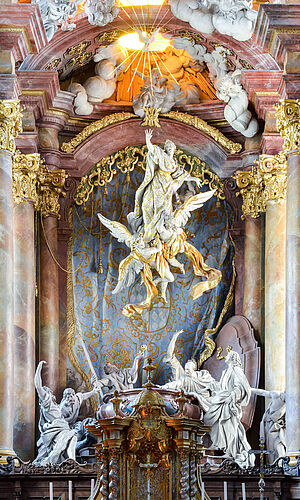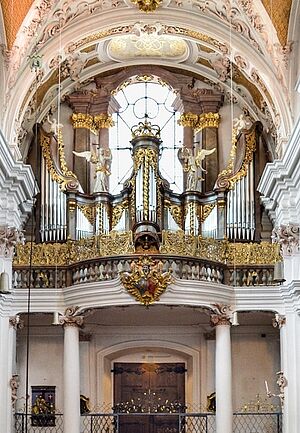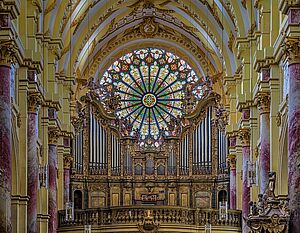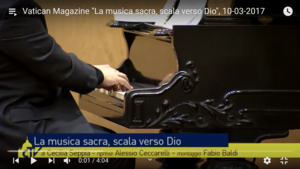B27 The liberation of music from the embrace of the church
Symbols cannot be right or wrong. There are no fakes, because symbols are nothing more than carriers of consciously defined meanings. The 1 and 8 can stand for the alpha and the omega (Altar of Besançon from 1050), but also for Adolf Hitler due to the assignment to the first and eighth letters of the alphabet. There is no right or wrong in a causal sense. That alone determines the respective worldview. Ultimately, everything can be explained as a symbol or sign for something.
Christian symbolism is particularly complex, and to understand it it is necessary to look at the world from the educational and spiritual perspective of the early Christians. We have both written sources and works of art in abundance at our disposal.
If everything we see around us is God's creation, then, so the thought, everything should also contain a reference to him, a corporate identity of the world manufacturer to a certain extent - incidentally a useful rhetorical maneuver as argumentation aid against the polytheism of the Greeks and Romans. From the 3rd century onwards, decisions were made about which texts belong in the book of books and the symbolic contexts slowly took shape.
The view into the sky revealed 7 wandering stars (Sun, Moon, Mercury, Venus, Mars, Jupiter and Saturn), over which a fixed sea of stars appeared. The Egyptians and Greeks already knew that. The sky impressed most of all, so the abode of God was located - following the tradition of older cultures - where one assumed eternity: in the unchangeable sea of stars that could be mentally mapped with recognizable constellations. Among them, 7 spheres were assumed, corresponding to the moving stars. The earth in the center and above it the impressive sky, it all seemed to be eternal and therefore had to form the starting point for symbolic considerations - precisely because it could not be changed.
Nicolas of Oresme (* 1330 - † 1382), the eight heavenly spheres, Bibliothèque nationale de France
If the Bible had been taken as a starting point, other figures would have been available, but they did not match the observations of the sky. The connections should however be catholic, from the Greek καθολικός (catholicós) "concerning the whole", ie all-encompassing. Therefore one agreed on 8 of 12 beatitudes and increased the number of the gifts of the Holy Spirit from 6 to 7. Also the definition Only 5 wounds must have been the basis of a decision, because either the crown of thorns is ignored or the wounds on the feet are counted as one because of the one nailed through both. Hardly anything can refer to a proven origin that would find such an impressive expression in the arts in later centuries. In the case of the Trinity, too, we are dealing with a definition that has no biblical origin. See video presentation VIII "Introduction into Christian numerical symbolism as basis for research."
It is no different in music, which - based on the research results presented on this page - can now be included for the first time to reconstruct the worldview. The Latin numbering from the prim to the octave includes both whole and semitone steps. This may be mathematically hair-raising, but the reference to consonance gives an indication of the alpha and omega as well as to the biblical days of the week, the counting of which begun with the dies dominicus. The spheres of heaven have already been mentioned. The Swiss music scholar Glareanus (* 1488 - † 1563), whose works ended up on the index, reports that of the 14 keys (7 in the mode authenticus and 7 in the mode plagalis) only 8 - or rarely 13 - were recognized, which in turn corresponds to the number of bliss and the number of participants in the last Last supper. Today's keyboard has 13 keys per octave - with only 12 tone names, as the first and last have the same name. This results in a numerical reference to the betrayal (13-1), death (5) and the resurrection, which took place on the eighth day - all in all a short version of the Gospel, see video presentation XII "On the genesis of the keyboard".
Interval designations such as “minor second” (small two) and “major third” (big three) - later requirements in order to be able to maintain the counting up to eight - provide a comprehensible explanation for why people talked about the “dark Middle Ages” in later centuries, because symbolic references are regularly linked to the abandonment of logic due to their free choice and the possibility of multiple interpretations. Otherwise, they could also be independently reconstructed elsewhere. There is something dogmatic about symbols: they are believed and decided, represent an unquestionable opinion. Critics see a helpless handling of numbers, just to be able to hold something in hands that somehow looks like mathematical law. Cardinal Nikolaus von Kues (* 1401- † 1464) provided the reason for this by writing. "If we cannot approach the divine in any other way than through symbols, we will most appropriately use mathematical symbols, for these have indestructible certainty." The use of numbers alone does not guarantee the correctness of a calculation, and symbols and postulates do not lead to any knowledge per se - they only stagnate at the level of one's own opinion. Behind the mathematical numbers and the Christian symbols, despite the same appearance, there are completely different sets of rules. In mathematics the respective numerical value is defined along with the permissible arithmetic operations, in theology the meaning. To overlook this would be a serious mistake. It comes to light through experimental mixing: for example, by pulling the square root of the seven gifts of the Holy Spirit.
Since we cannot assume that the learned cardinal lacked a rational distinguishing power, his formulation reveals missionary calculation by exploiting the suggestive effect of numbers - de facto a deliberate pretense of false facts. A correct statement would have been: "We would certainly like to prove the existence of God, but we cannot." So we observe in many places: Christian symbolism does not stick to the truth and its aim is tendentious. This can be clearly shown using the pseudo-mathematical musical interval designations, which in turn are based on physical frequency relationships. The way to the octave was visibly cheated.
Previously it was believed that music came directly from God and that, conversely, he heard the music that was performed in order to praise him. The fading of the tones was therefore not perceived as such, but viewed as a successive removal, like a diffusion into the hereafter, so to speak, so that a communication with the Most High could come about as in prayer. The motto MUSICA DONUM DEI can be read on many organs and also: MUSICA PRAELUDIUM VITAM AETERNAM. The immaterial nature of the sounds was just as suitable for spiritual practice including the experience of happiness as the immaterial nature of the light, as long as the instrumental and architectural self-presentation was disregarded. The Gothic cathedrals in particular owe their appearance to the desire for the largest possible windows.
Causality, physically precise descriptions, and wanton stipulations based on beliefs have been irreconcilably opposed to one another for centuries and neither Galileo Galilei nor Charles Darwin have been able - and never tried - to end the clinging to symbolism once and for all. The language of the symbols and analogies speaks to other brain regions - devotional candles have a different function than light switches - causes content to be firmly anchored and has an effect on the psyche, depending on the dosage and depth of penetration, up to what can be described as brainwashing - or should one better say "emotional persuasion"? In this context, the clashes of the churches with sects are revealing - in particular the statements about what must be regarded as right, wrong or even harmful, what can be regarded as belief or should be rejected as superstition - i.e. the mechanisms of action are well known to the pastors. The means by which the established doctrines were implemented and the financial interests behind it speak for itself.
The more powerful the symbolic building, the sooner it is possible to proclaim closeness to God up to personal representation and therefore appeals for donations, which often contain concrete requests for testamentary dispositions, regularly end with the comforting promise that every good deed in the hereafter would be rewarded. Anyone who says such a thing must be very knowledgeable and calculate with the other person's concern for his soul. The conceptual structure is circular conclusive - the developers made sure of that.
The ways in which symbolism is dealt with cannot be specifically discussed here; they differ greatly in the course of history and, once again, in the various denominations. Suffice it to say here that the spectrum extends from pastoral work (consolation, hope) to complete submission, even to burning people alive, because no other viewpoint was accepted. Not infrequently, Jews were accused of desecrating consecrated wavers in order to be able to expropriate them and ban them from cities or entire regions. Symbolism is only seemingly a harmless substance. (see blog B 12: Symbols - mirrors of man). In the opposite direction symbols are completely harmless, only the behavior of the "homo sapiens" is questionable.
In the liturgical area, symbolism occurs in a special concentration and here, too, it is important to differentiate, because dealing with it leaves the contents of faith as such completely untouched. Symbolism is an expression of belief, not itself an object of belief, and cannot be used as a causal basis for the truth of a worldview. The host represents a special case, which after transubstantation in the literal interpretation of the words: "Take it; this is my body" Mk 14:22 is seen as the real body of Christ, in which Christ is truly and permanently present.The process known as consecration turns the believers into witnesses of an imaginary miracle. This is a matter of pure but not undisputed faith, as it cannot be rationally understood any more - as well as the counting mode of the sound material - because Jesus did not actually cut his own body apart but broke the bread with the request "Do this in remembrance of me." Luk. 22.19-20. The significance of the consecrated hosts is expressed by the term Holy of Holies. A symbol cannot be valued more highly.
In the practical cult, the host is part of a related program which addresses all the senses: smell (incense), hearing (music), visual sense (light, images, sculptures, architecture), taste (host, wine) and touch (holy water). Particularly relevant here is becoming part of something through feeling, not through rational questioning, because symbolism carries a meaning and always means something else that lies behind things.

Grapevines at Talin Cathedral, Armenia with reference to John 15.4: "I am the vine and you are the branches."
The awe-inspiring beauty of the arts continues to attract many millions, and it is analogies that make them beautiful, including analogies with human anatomy such as symmetry. This makes identification and affection possible and architecture and music can move deeply. The theological aspect was woven into it and permeates occidental culture. This is a deliberate instrumentalization of the arts - hence the huge investments for it. Beyond the Bosporus, other sets of rules apply and the symbolic references that are visible from afar in architecture and audible in music are suddenly missing: instead of the bells ringing, the muezzin calls.
Looking back, one gets an idea of what contemporaries must have felt when the worldview based on symbolism collapsed with the Copernican turn. It's like the sky has collapsed. Suddenly nothing was as it used to be. The foundation was removed and the meaning of the term "Catholic" was virtually erased. What had previously been unequivocally associated with bliss, the eight heavenly spheres, now belonged to the past. Since then there have been wrong symbols - such as the octave, the octagonal imperial crown, Castel del Monte, the Palatinate Chapel in Aachen, octagonal baptisteries and pulpits, the eight parts of speech and much more, because they all point to a point of view that must be considered out of date.
The aftermath can still be felt today. Only in the liturgy, which since then can be described in two ways as a ritual of reenactment, has retained a little of its old splendor. The works of art became silent witnesses to that self-staging and their meaning was forgotten. The Christian symbolism of the Western sound system is no longer even mentioned in lexica.
How could you ever get back on your feet after this disaster? The following is an example from the Rohr monastery in Lower Bavaria. The term theatrum sacrum was associated with the Baroque due to the stage-like presentation of the biblical events. Although it seems inappropriate to speak of symbolism in view of such clarity of depiction, the carrier material transports only parable for Mary or for the astonished disciples - even if we knew that they really once would have looked like - and the fully plastic image even shows the inner movement of the depicted persons. Art has taken the place of the viewer's inner world of imagination.
Assumption of Mary, Egid Quirin Asam, Rohr monastery, Lower Bavaria (Click on the picture to enlarge.)
The fact that the organ in the nave opposite musically also symbolizes the ascent to heaven is easy to justify on the basis of the presented research results, because the diatonic scale was centuries earlier associated with the Jacob's ladder. Much older cultural assets are presented here. Bliss is acoustically represented by consonance, symbolically by the term octave - cf. Video presentation VII: "How the octave got its name" - because the numeral meaning has long been passed from the heavenly spheres to the bliss and the heaven of God is expected, where the light comes from. Therefore the window behind the crowned organ has the same liturgical meaning as the window above Mary. Comparisons with other sacred buildings show that we are not dealing with an individual case with this emphasized appreciation of light and sound.
Organ, Rohr monastery , Lower Bavaria
Rose window and organ, Ebrach monastery, Franconia
Rose window and organ, Notre Dame, Paris
Let's go back again. The Gothic cathedrals were able to bring the Heavenly Jerusalem to earth in a completely different way - above all with a special feeling for the immateriality of light and sound in connection with the abstractness of numbers. The pure language of the symbols is more subtle, more puristic, the approach is much more inner and connects what is seen with the previously acquired knowledge about it. The viewer must already bring this knowledge with him, because it does not explain itself to outsiders.

Swallow's Nest Organ, Basilique de la Valere, Sion, Switzerland. Octagon-shaped swallow's nest under an octagon, embodying the 8 bliss. The incident light is connected with the saying: "I am the light of the world", Joh. 8,12. In an analogous way, the equally immaterial music is to be regarded as a gift from God. The same symbolic content also in the non-visible area, i.e. to discover in the systematics of tones goes one step further and makes one think of the saying: "Blessed are those who do not see and yet believe", Joh. 20,29. This is how the path leads from sensory perception to spirituality. It is the inner values, the so-called 7 gifts of the Holy Spirit, which, like the steps on Jacob's ladder, lead to God: fear of God, piety, love of neighbor, bravery, mercy, love of enemies and wisdom.
Taking up the topic as a scientist, despite the emphasized appreciation of the interdenominational and intercultural ethical content: charity, bravery, mercy, love of enemies and wisdom, lead to well-known reactions. First there is the rejection of the Vatican: "It is not the task of the Pontificio Consiglio della Cultura to approve scientific theories" - offers for lectures were rejected without giving reasons, the recommendation of the Pontificio Istituto di Musica Sacra ignored - its Preside, Monsignor Vincenzo De Gregorio, had written a foreword to the submitted book manuscript - the publication promise of the Libreria Editrice Vaticana withdrawn without a substantive statement - only to take up a research result from it only a little later. "La musica sacra - scala verso Dio" - was the title of a music science symposium in the Vatican in 2017 - underscored with a depiction of a pianist at the grand piano.
Reporting on the 2017 symposium: "La musica sacra, scala verso Dio". (Click on the picture to zoom in.)
As explained above, Jacob's ladder was used for the pictorial interpretation of the diatonic system. The latter forms the oldest part of the keyboard, recognizable today by the white keys of the piano. Jacob's ladder, for its part, defines the house of God, because Jacob finds out about the place of his dream vision: "Here is nothing other than God's house and here is the gate of heaven", Gen. 28:17. Accordingly, the importance of music in the occidental sacred space can hardly be overestimated. More recent studies even show that church floor plans can be based on the step sequences of church modes - as praise of God turned into stone.
Obviously the trauma of the upheaval scientific discoveries is still too awake, and the longing for an ideal symbolic world too pronounced to allow an objective separation from the actual beliefs. The fatal thing about it lies in the principle of action as such: People tend to equate the symbol with the content. This has already been observed with the waver sacrilege and it is exactly the same with the oath of the flag. The material bearer of symbols does not suffer any pain. When a flag is burned it does not scream, but whoever identified with the symbol is hurt. That is usually the intended purpose behind such a burn. This reveals a quality of symbolism that gives it power over people - not unlike a voodoo doll. It is more than necessary to consciously reflect on this, because the claim just made is not really correct! It is not a question of a property of symbols, but rather of a property - the vulnerability - of the human being who is able to put so much of his identity into the symbol - that criticizing it hurts himself. Once the world of emotions is on fire, and this is regularly the case with the destruction of cultural assets, the defensive reaction is closer than the analytical consideration.
Because transubstantiation means more than memory with the help of symbols - therefore it is under special protection through dogmatization, Hans Albert and Karl Popper see it as an immunization strategy - the beliefs collide with science and the world of emotions with rationality. Social psychologists speak of cognitive dissonance in terms of the result. The measures that people take to cope with them can be observed in many places in the past and present. One of the typical ones is the simple ignorance of the facts, the looking over the determined incompatibility. However, this is based only on an assertion with the aim of performing miracles and being able to proclaim an exclusive claim to the Savior, which can now be precisely located in the tabernacle. The fear of suffering in this world and the hereafter as well as the hope of a happy eternal life lead people to uncritically accept what is ordained by the church and to ignore rational thoughts. This is another reason for the rejection: It lies in the principle of critical questioning and in the uncovering of the suggestive effect of symbolism, because if you mentally fade out all great sacred works of art, including music, a considerable part of the church's attractiveness would be lost and the return to the original content would result in a renewed Reformation of unimagined proportions.
Therefore, another hidden meaning behind the symbolism needs to be addressed at this point, because the pretense of false facts was by no means purposeless. Since early Christianity, the rapidly increasing number of believers - today one would speak of followers - was associated with an immense increase in power and the taxes and donations received were not only used to pursue humanitarian goals. Without this development of power, to which the educational monopoly soon added, the Crusades, the violent conversion and persecution of people of different faiths, as well as the Inquisition would have been unthinkable. In the 16th century the sale of indulgences was added as a means of maximizing income and was denounced by Martin Luther as well as all the additional teaching content that could not be derived directly from the Holy Scriptures - keyword: "sola scriptura". But that's not all. Only the Enlightenment and secularization put an end to the overwhelming power of the church and it speaks for itself if one intended to refrain from any symbolism with the introduction of new time calculation, i.e. with a new calendar, the 10-day week and the 10-hour day.

Revolution clock with decimal display, Napoleonic time, Museum for Clocks, Jewelry and Art, Frankfurt am Main.
Christian symbolism was no longer noticed in music. J.S.Bach had defended it with such vehemence (see blog. C3: "J.S. Bach's Credo in Image and Sound"), but in the theory of harmony published by Charles-Simon Catel in the tenth year of the Revolution, we read in the prefave the oracular-like formulation: "... pour combattre des ereurs, que le tems a consacrées, et que le tems doit détruire". This is what Etienne Nicolas Méhul said, who in his youth had trained as an organist in the Franciscan monastery in his hometown of Givet and later worked in the Laval-Dieu monastery. Due to his political commitment and not least because of his compositions of national anthem character - Chant national du 14 Juillet 1800 - he was entrusted with the editing of the work by a specially appointed commission and the same commission asked him to report to the general assembly and thus to a committee who would have had the least understanding for a MUSICA DONUM DEI. Attempts at theological interpretation had lost nothing in the Conservatoire National Supérieur de Musique et de Danse de Paris, which was just founded in 1795 and already at that time, Méhul was named one of the 5 inspectors of the institution.The sentence quoted above seals the end of Christian symbolism in occidental harmony after around 1500 years and frees the art of music from the captivating embrace of the church.
In contrast, the new theory of harmony has become one of the most widely received music theory works in France and has been translated into several languages. A look inside reveals a merely minimalist intervention, because the "prim" is referred to as "unison" and thus loses its status as an interval that never belonged to it. A reference to the A and Ω is thus shown to be unfounded, while the octave had already lost its meaning through Copernicus. In this respect, Méhul should be right. Time has rolled over the events of its own accord and has made the knowledge of the abundant Christian symbolic references disappear from the minds of the people. Even at the Pontificio Consiglio della Cultura one no longer has any knowledge of it. Time just left behind a broken musical system, the appearance of which is neither Greek nor Catholic nor can be called rationally permeated, because it contains only a part of all of this.
Charles-Simon Catel, Traité d'harmonie, bilingual edition
The fragments of the old world views now lie in the sediments of history and only the reconstruction makes it possible to get to the meaninggiving thoughts of the conserved testimonies. For the benefit of society, science is concerned with gaining knowledge through observation, description and the analysis of contexts.
But how does the present relate to all of this? On the one hand, it is understandable that after the Enlightenment it called for an extensive separation of church and state and therefore tried to exclude the religious aspect from music. The fear of religiously motivated terror attacks like the one on October 16, 2020 near Paris supports this intention. On the other hand, it is impermissible to pass on knowledge of cultural-historical relationships to subsequent generations only in a censored manner, and not to include the material in the curriculum. Censorship and freedom contradict each other because information is the necessary basis for forming an opinion. How manipulation works can hardly be conveyed other than by means of examples, and it is worthwhile to compare the ways in which companies, political parties, religions and other interest groups try to convince and influence people. Where are the points where legal boundaries become necessary, as in the case of the protection of minors, surreptitious advertising or misleading? At what point should particular attention be drawn to deliberate false pretenses? The most effective antidote to the suggestive effect of symbols is to learn to use them consciously and that only happens through education. In that case, however, information about it must be freely accessible.
It is the task of the educational institutions to create order and differentiate between structures that have evolved over time: what are the Greek roots of our sound system, what are the interpretations of the early Christians, how did our keyboard appear and how did the tempered tuning come about? All of these questions are now answered and there is no good reason to hold them back. Research is able to start afresh at numerous points in order to deepen the content.
The overall view gives rise to reflections on man himself, because evolution did not aim at "homo sapiens" - as he is called it himself - but only left behind on our planet what could be survived and reproduced - with whatever strategy. For this reason alone, it would be advisable to get to know your own thinking apparatus thoroughly and to look at it self-critically in order to be able to counter undesired indoctrination and misjudgment. What do religions, cultural homes, what symbolism mean to people, and how vulnerable is it compared to apparently consistent statements to avoid cognitive dissonance? How synergistic is it with like-minded and dissenters? What contribution can the parable of harmony make?
This global ethic, recently rediscovered by the author, is based on the Greek model, because as the daughter of Ares (god of war and bloody slaughter) and Aphrodite (goddess of love), Harmonia was existentially between the fronts and had to strive to find a balance. How much knowledge of human nature is behind these kinship relations of Greek deities! With the term "love of enemies" the problem was taken up by the Christian worldview and for the reasons presented above it was now called octave, which was previously also called harmonia due to the impressive acoustic consonance. So the connection of music with the divine is not a Christian achievement.
The interpersonal problem as such has survived. Combining extreme opposites synergistically is still the most difficult task that people can be confronted with. Only those who are lucky enough to be able to live and indulge in peace and harmony forget it all too easily. In addition, there is the defamation of the advocacy of harmony as a sign of weakness: "Women stuff! You have to be able to assert yourself in society!" The assignment to the sexes can already be read from the Greek model. So we come back from the world of gods to earthly realities: Reason is not the sole decision-maker in the human brain - otherwise addictive substances would not pose a threat - and ethical content is also in compassion, which does not allow wars. Yet they take place. Therefore, there is a conflict constellation in every individual thinking apparatus that does not function automatically in the interest of the common good. We are dealing with a fundamental problem, not a specifically religious one, because conflicts arise where ever power interests come into play. Past and present provide sufficient material for studying one's own species. Quite a few contemporaries like Frank Urbaniok warn of a renewed wave of spiritual darkness that would be pure poison for a democracy.
How the church relates to all of this, whether it succeeds in delimiting contemporary content truth-oriented from historical, or whether it remains clinging to old thought patterns, remains to be seen. Does it take the risk of innovation, or does it rely on tried and tested means that have proven to be successful in a sufficiently uninformed society? In the past it profited from a social development that it herself had thwarted.
It will be the media that report on it and enable a public discourse. Therefore, the appeal is renewed to also perceive the extremely important control-, information- and opinion-forming function, to take up socially critical thoughts and not to follow out of commercial interest - what a tragic synchony! - the complacent mainstream. Because of such relapsing tendencies, a saying by Immanuel Kant is of lasting relevance: "Have the courage to use your own understanding".
© Aurelius Belz 2021








